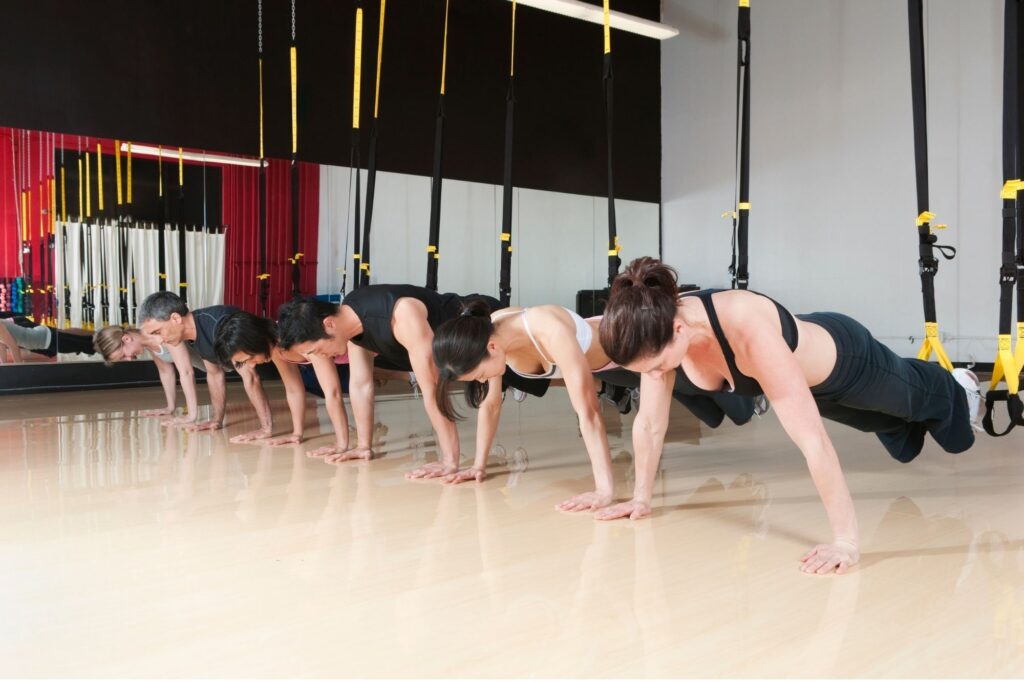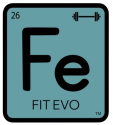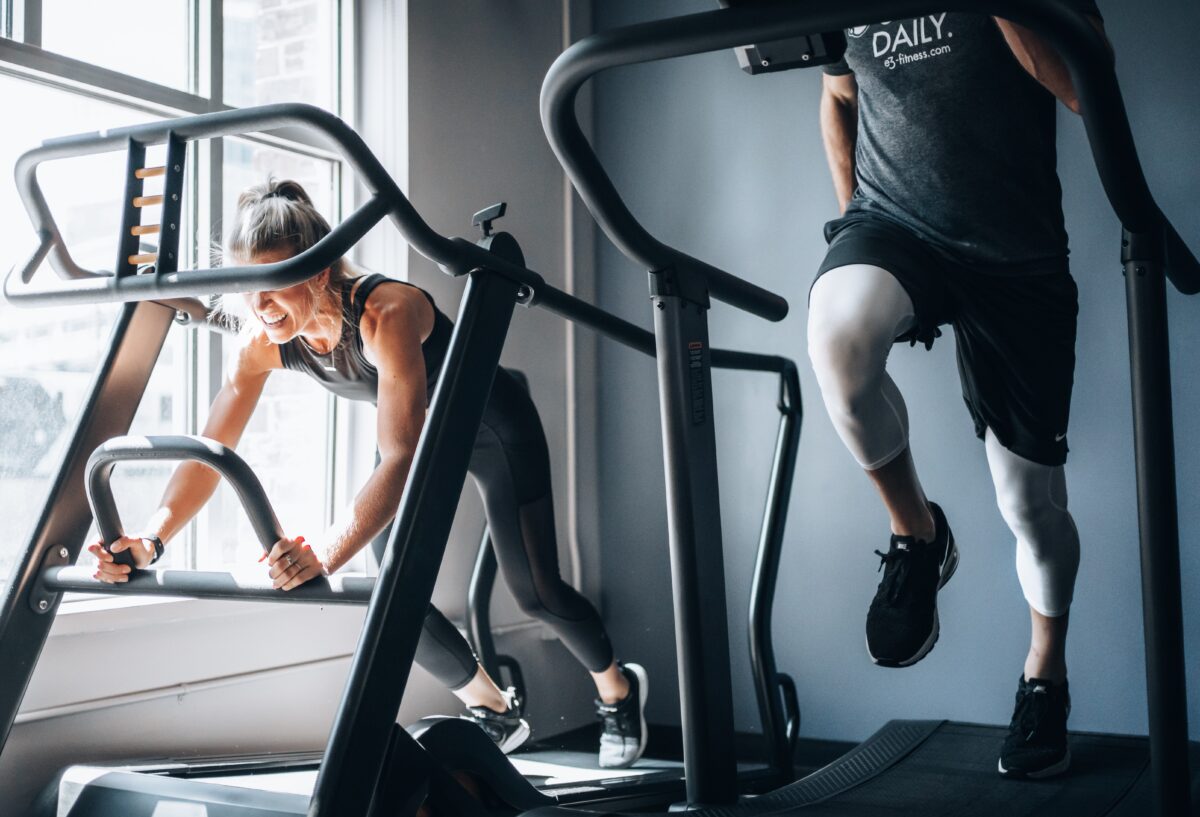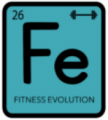You might be wondering – is it okay to do HIIT everyday? Should you incorporate it into your fitness routine or consult a personal trainer? Well, you’ve come to the right place!
What Is A HIIT Workout?
High-intensity interval training (HIIT) has gained immense popularity in recent years due to its efficiency and effectiveness in burning calories and improving cardiovascular fitness.
Many individuals now prefer this type of high-intensity exercise over traditional workouts. It is highly recommended to work with a personal trainer when engaging in intense training to ensure proper form and maximize results. But before you dive headfirst into your daily high-intensity interval training (HIIT) workouts, it’s crucial to understand the limits of this intense fitness routine.
While HIIT can be an effective workout to achieve your fitness goals, it’s essential to listen to your body and avoid overdoing it. A high-intensity Tabata workout for just a few minutes can push your limits and yield fantastic results. Running a high-intensity interval training (HIIT) workout for too many minutes without giving your body enough time to recover can lead to potential risks.
Running, too much HIIT, and Tabata workouts can lead to increased muscle soreness, fatigue, decreased performance, and even an increased risk of injury within minutes.
The Benefits of HIIT: Maximizing Calorie Burn and Fitness Levels

ALT TAG: Is it okay to do HIIT everyday? by Fitness Evolution
High-intensity interval training (HIIT), such as Tabata, has gained immense popularity among fitness enthusiasts in recent years. With just a few minutes a day, you can experience the benefits of this intense workout.
Check out our related article for more information on how to incorporate Tabata into your weekly fitness routine. This HIIT workout involves short bursts of intense activity for minutes, followed by brief recovery periods. Try this Tabata routine for a week and feel the burn! Many people wonder if it’s okay to do HIIT everyday for several minutes.
High Calorie Burn During And After A HIIT Workout
One of the primary advantages of HIIT is its ability to maximize calorie burn both during and after a workout. With just a few minutes of high-intensity exercise per week, HIIT can help you achieve significant results. Unlike traditional cardio workouts, HIIT focuses on short bursts of intense activity, which can increase your metabolism, and burn calories more efficiently.
In contrast, during a LISS workout, the intensity is lower and the focus is on low-impact exercises for an extended period of time. This leads to a higher metabolic rate, resulting in more calories burned compared to steady-state exercises like jogging or cycling.
The “afterburn effect,” or excess post-exercise oxygen consumption (EPOC), plays a crucial role in calorie expenditure during both HIIT workouts and LISS exercises. After completing a HIIT session, your body continues to burn calories at an elevated rate for hours due to increased oxygen demand and the replenishment of energy stores.
This is why HIIT workouts are great for weight loss and increasing metabolism. The intense bursts of exercise in a HIIT routine help boost your metabolism, allowing you to continue burning calories even after the workout is over.
Improved Cardiovascular Fitness Through Intense Intervals
Regular participation in HIIT workouts can greatly enhance cardiovascular fitness levels. By pushing yourself to your maximum effort during each interval, you challenge your heart and lungs to work harder than they would during moderate aerobic exercises.
The intense nature of HIIT stimulates adaptations within your cardiovascular system. Over time, these adaptations lead to improved oxygen delivery throughout the body, a reduced resting heart rate, lower blood pressure levels, and enhanced overall endurance.
Time-Efficient Workouts For Busy Individuals Seeking Fitness Gains
For those with busy schedules who struggle to find time for exercise, HIIT offers an efficient solution. Traditional cardio workouts often require longer durations to achieve the same fitness benefits as a HIIT session. With HIIT, you can achieve similar or even greater results in less time.
HIIT workouts typically last between 15 and 30 minutes, making them easily adaptable to fit into even the busiest of schedules. This time efficiency allows individuals to incorporate regular exercise into their routine without sacrificing other commitments.
Tailoring HIIT to Your Fitness Goals And Level
One size definitely does not fit all. It’s important to customize your HIIT sessions based on your individual fitness goals and current fitness level. By tailoring your workouts, you can maximize the benefits of HIIT while minimizing the risk of injury or burnout. Here are some key factors to consider when customizing your HIIT routine in Bellingham, Washington:
Customizing Intensity Levels Based On Individual Fitness Goals
Short rest intervals followed by intense exercise bursts are hallmarks of HIIT training. However, the level of intensity can vary depending on your specific fitness goals. If you’re aiming to improve aerobic fitness and endurance, longer intervals with moderate intensity may be more suitable. On the other hand, if you’re looking to enhance explosive power and strength, shorter intervals with high-intensity exercises could be more effective.
To tailor the intensity of your HIIT session:
- Determine your desired outcome. Are you focusing on improving cardiovascular health, building muscle, or losing weight?
- Adjust work-to-rest ratios: Experiment with different ratios (e.g., 1:1, 2:1) to find what challenges you without pushing you too far.
- Incorporate different types of exercises: Mix up cardio-based movements like jumping jacks or burpees with strength-building exercises like squats or push-ups.
Adapting Exercises To Match Personal Preferences And Abilities
One of the great things about HIIT is its versatility. You can adapt exercises according to your personal preferences and abilities. This ensures that you stay engaged and motivated throughout your workout while avoiding movements that may cause discomfort or strain.
Consider these options when adapting exercises:
- Modify high-impact moves: If jumping is challenging for you due to joint issues or injuries, replace it with low-impact alternatives such as step-ups or marching in place.
- Use equipment or bodyweight: Incorporate equipment like kettlebells, resistance bands, or dumbbells to add resistance and intensity. Alternatively, you can rely on your body weight for a highly effective HIIT session.
- Explore different HIIT formats. Tabata workouts, for example, consist of 20 seconds of intense exercise followed by 10 seconds of rest. This format allows for quick bursts of effort and can be easily customized to fit your preferences.
Finding the Right Frequency for HIIT Workouts
Finding the right frequency for HIIT workouts is crucial to ensuring that you are reaping all the benefits without overexerting yourself. There are several factors to consider, including your age, fitness level, and overall health. Let’s dive into these considerations and explore some guidelines for incorporating HIIT into your exercise routine.
Start With 2-3 Sessions A Week
Starting with 2 to 3 sessions per week is a general guideline that works well for most individuals. This frequency allows your body enough time to recover between workouts while still providing ample opportunities to challenge yourself. However, it’s important to remember that everyone is different, and what works for one person may not work for another.
Age
Age plays a significant role in determining the frequency of your HIIT workouts. As we age, our bodies may require more time to recover from intense exercise. If you’re in your 20s or 30s, you might find that doing HIIT three times a week suits you perfectly. On the other hand, if you’re in your 40s or beyond, it might be wise to start with two sessions per week and gradually increase as your body adapts.
Current Fitness Level
Your current fitness level also influences how often you should engage in HIIT workouts. If you’re just starting out or have been relatively sedentary, it’s essential to gradually ease into this high-intensity training. Before considering additional sessions, begin with two weekly sessions and assess how your body responds. Over time, as your fitness improves and you become more comfortable with the demands of HIIT, you can gradually increase the frequency.
Body Signals
Listening to your body’s signals is crucial when determining the appropriate frequency of HIIT workouts. Pay attention to how well-recovered you feel after each session, and note any signs of excessive fatigue or soreness. If you find that it takes longer than usual to recover or if you experience persistent muscle soreness, it may indicate that you’re pushing yourself too hard. In such cases, consider reducing the frequency of your HIIT workouts and allowing more time for recovery.
Incorporating Variety
Incorporating variety into your exercise routine is also important. While HIIT workouts can be highly effective, performing them daily without variation can lead to burnout or overuse injuries. To prevent this, consider alternating your HIIT sessions with other forms of exercise like strength training, yoga, or low-impact cardio. This not only helps prevent boredom but also allows different muscle groups to recover while you continue to work on improving overall fitness.
Timing and Recovery: Avoiding Overtraining and Injury
Allowing sufficient rest periods between intense workouts is crucial for avoiding overtraining and injury. While high-intensity interval training (HIIT) can effectively improve your fitness, doing it every day without proper recovery can lead to negative consequences.
Engage In Low-Intensity Activities
Incorporating active recovery days into your routine is essential for optimal performance and injury prevention. Active recovery involves engaging in low-intensity activities that promote blood flow and help the body recover from intense workouts. This could include activities such as light cycling, swimming, or yoga. By giving your muscles a chance to recover while still staying active, you can reduce the risk of overuse injuries.
Recognize Signs Of Overtraining
Recognizing signs of overtraining is vital to maintaining your health and performance levels. Pushing yourself too hard without enough rest can lead to fatigue, decreased performance, and even increased susceptibility to illness. It’s important to listen to your body and take note of any warning signs that indicate you may be overtraining.
Get Enough Sleep
Proper sleep plays a significant role in recovery and overall health. During sleep, the body repairs damaged tissues restores energy levels, and regulates hormone production. Aim for seven to nine hours of quality sleep each night to support optimal recovery from intense exercise sessions.
Rest periods during HIIT workouts are essential for the body to recover between intervals. The duration of these rest periods depends on several factors, such as fitness level, workout intensity, and goals. Typically, rest periods range from 10 seconds up to a minute or longer. Adjusting the length of these intervals allows you to challenge yourself while giving your body adequate time for recovery.
Sugar Control
Sugar control is another aspect worth considering. Intense exercise like HIIT relies heavily on glycogen stores for fuel. If you do HIIT everyday without allowing enough time for glycogen replenishment through proper nutrition or rest days, you may experience a decline in performance and potentially compromise your health. Balancing your sugar intake and ensuring adequate recovery periods can help optimize your HIIT workouts.
Joint Health Considerations in HIIT Training
High-intensity interval training (HIIT) has gained popularity as an effective way to improve cardiovascular fitness and burn calories. However, before diving into a daily HIIT routine, it’s important to consider the impact of these high-intensity movements on your joints.
Impact Of High-Intensity Movements On Joints
HIIT workouts typically involve explosive movements such as jumping, sprinting, and quick changes in direction. While these exercises can improve fitness levels, they also place significant stress on the joints. The repetitive impact from jumping jacks or burpees can lead to joint discomfort or even injury if not performed with caution.
It is crucial to prioritize proper form and technique to mitigate the risk of joint problems during HIIT sessions. Maintaining good alignment throughout each exercise helps distribute forces evenly across the joints, reducing the likelihood of excessive strain.
Importance Of Proper Form To Minimize Joint Stress
When performing HIIT exercises, paying attention to your body’s alignment and movement patterns is paramount. Here are some guidelines for maintaining proper form:
- Neutral spine: Keep your back straight and avoid excessive rounding or arching.
- Engage core muscles: activate your abdominal muscles to stabilize your torso during dynamic movements.
- Land softly: When executing jumps or plyometric exercises, focus on landing gently with slightly bent knees to absorb shock.
- Avoid overextension: Be cautious not to hyperextend your joints by fully locking them out during exercises like lunges or push-ups.
By adhering to these principles, you can significantly reduce the strain placed on your joints while maximizing the benefits of HIIT workouts.
Supplementing With Low-Impact Exercises Or Modifications When Needed
While HIIT training is known for its high intensity, it’s essential to listen to your body and make modifications when necessary. If you experience joint discomfort or have pre-existing joint conditions, incorporating low-impact exercises can help maintain joint health while still reaping the benefits of HIIT.
Consider adding these low-impact options to your routine:
- Cycling: Indoor or outdoor cycling provides a cardiovascular workout without excessive stress on the joints.
- Swimming: Water-based exercises are gentle on the joints while offering a full-body workout.
- Resistance training: Incorporate strength training exercises using resistance bands or weights to focus on muscle development rather than high-impact movements.
Remember, it’s crucial to consult with a healthcare professional if you have any concerns about your joint health before starting an intense exercise program like HIIT.
Incorporating Strength Training for a Well-Rounded Routine
Strength training is an essential component of any well-rounded workout routine. When combined with high-intensity interval training (HIIT), it offers numerous benefits that can take your fitness to the next level. By targeting different muscle groups and balancing cardio-focused intervals with resistance-based exercises, you can maximize the effectiveness of your workouts and achieve optimal results.
Benefits of Combining Strength Training with HIIT Workouts
Integrating strength training into your HIIT routine brings about a multitude of advantages. Firstly, it helps build lean muscle mass, enhancing your physical appearance and boosting your metabolism. As you engage in resistance training, your muscles are challenged and forced to adapt, increasing strength and endurance.
Incorporating strength exercises into your HIIT sessions can improve overall body composition by reducing body fat percentage while preserving muscle mass. This combination promotes a toned physique and better overall health.
Targeting Different Muscle Groups For Overall Strength Development
One of the major advantages of combining strength training with HIIT is the ability to target different muscle groups effectively. While HIIT primarily focuses on cardiovascular fitness and burning calories, adding resistance exercises ensures that all major muscles are adequately worked.
For example:
- Squats target the lower body, including the quadriceps, hamstrings, glutes, and calves.
- Push-ups engage the chest muscles (pectoralis major), triceps, shoulders (deltoids), and core.
- Deadlifts work the posterior chain muscles such as the hamstrings, glutes, erector spine (lower back), and traps.
By incorporating a variety of compound movements like these into your routine, you can achieve balanced muscular development throughout your entire body.
Balancing Cardio-Focused Intervals With Resistance-Based Exercises
While both HIIT and strength training have their unique benefits, finding a balance between them is crucial for an effective workout routine. HIIT workouts typically involve brief intervals of intense exercise and recovery. On the other hand, strength training focuses on lifting heavier weights with fewer repetitions.
Alternate Cardio And Resistance Workouts
To strike a balance, you can alternate between cardio-focused intervals and resistance-based exercises within your routine. For instance, you could start with a set of burpees or jumping jacks to get your heart rate up and then transition into strength exercises like lunges or bicep curls using dumbbells.
Maintain Good Form
Remember to maintain good form throughout your workout to prevent injuries and maximize results. If you’re unsure about proper technique, consider working with a trainer who can guide you through the exercises and ensure that you perform them correctly.
Incorporate Cardio And Strength Training
Incorporating cardio and strength elements into your routine provides a well-rounded workout, keeps things interesting, and prevents boredom. This variety challenges different energy systems in your body, leading to improved cardiovascular endurance, increased muscular strength, and enhanced overall fitness.
Avoiding Overtraining: The Dangers of Training Too Long or Too Often
Excessive training can have detrimental effects on your body and your overall fitness progress. It’s important to understand the negative consequences that come with pushing yourself too hard and not allowing enough time for recovery. Monitoring your training volume, intensity, and frequency is crucial to avoiding overtraining and maximizing your results.
Understanding The Negative Effects Of Excessive Training
Doing it every day may seem tempting for quick results. However, this approach can do more harm than good. Overtraining occurs when you constantly push your body beyond its limits without giving it sufficient time to recover. This can lead to a variety of negative effects, such as:
- Increased risk of injury: Constantly subjecting your body to intense workouts without proper rest increases the likelihood of strains, sprains, and other injuries.
- Decreased performance: Overtraining exhausts your muscles and central nervous system, resulting in decreased strength, endurance, and overall athletic performance.
- Weakened immune system: Intense exercise places stress on your immune system. Without adequate recovery time, your body’s ability to fight off infections may be compromised.
- Hormonal imbalances: Excessive training can disrupt hormonal balance in both men and women, leading to irregular menstrual cycles or decreased testosterone levels.
Monitoring Training Volume, Intensity, And Frequency
To avoid overtraining and its associated risks, it’s essential to carefully monitor three key factors: training volume, intensity, and frequency.
- Training volume is the total work performed during a workout session or week. It includes factors like repetitions completed or distance covered.
- Intensity measures how challenging each workout is relative to your maximum effort level.
- Frequency indicates how often you engage in high-intensity workouts within a given timeframe.
Finding the right balance among these factors is crucial. Here are some tips to help you monitor them effectively:
- Gradually increase training volume and intensity. Avoid sudden spikes in your workout load, as this can increase the risk of overtraining. Instead, gradually progress by adding small increments each week.
- Incorporate active recovery days: On these days, engage in low-intensity activities like walking or yoga to promote blood flow and aid muscle repair.
- Listen to your body. Pay attention to signs of fatigue, persistent muscle soreness, or decreased performance. These may indicate that you need more rest.
Final Thoughts: Is It Okay To Do HIIT Everyday?
Now that we’ve explored the various aspects of HIIT training and its benefits, let’s address the burning question: Is it okay to do HIIT everyday? The answer depends on several factors. While HIIT can be an efficient way to burn calories and improve fitness levels, doing it every single day may not be ideal for everyone. It’s crucial to listen to your body and find a balance that works for you.
Overtraining can lead to fatigue, decreased performance, and even injury. Your body needs time to recover and repair itself after intense workouts. So instead of pushing yourself too hard with daily HIIT sessions, consider incorporating other forms of exercise into your routine. Mix in some strength training or low-impact activities like yoga or swimming. This will help you achieve a well-rounded fitness regimen while giving your body the rest it needs.
While HIIT has numerous benefits, including maximizing calorie burn and boosting fitness levels, doing it every day may not be suitable for everyone. It’s essential to find a balance that allows you to challenge yourself without overexerting your body. Remember, fitness is a journey that should be enjoyable and sustainable in the long run.


